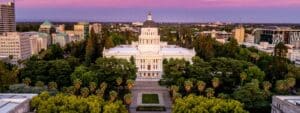The Brisbane City Council will review the proposal tomorrow for Universal Paragon Corp.’s 684-acre Baylands site, a plan to build commercial, residential and open space that has been seeking approvals for 11 years.
The controversial project has turned into the ultimate showdown between state and regional efforts to encourage housing near transit and address the Bay Area’s housing shortage, and local desires to resist it. The debate circles around how much control a city should have over its own land use policy when that policy affects an entire region.
“This site is one of the last major undeveloped areas in the core Bay Area,” said Jonathan Scharfman, development director for Universal Paragon. “We believe that housing adjacent to the most underutilized Caltrain station on the corridor is an essential component to a sustainable project.”
Universal Paragon wants to build nearly 7 million square feet of commercial space — including 566,300 square feet of retail and 5.9 million square feet of office and R&D — as well as 369 hotel rooms and 4,434 residential units.
A community-backed alternative developed after three years of planning and more than 50 public meetings calls for up to 7.7 million square feet of office, industrial, commercial and other uses — except housing.
In August, the city’s planning commission came up with its own recommendation of up to 2 million square feet of commercial and no housing.
Over the next several months, the city council will consider the developer’s proposal for the site along with alternatives developed by a community input process and the city’s planning commission. The council is expected to make a final decision sometime after May of 2017.
Despite Brisbane officials demanding no housing, state laws such as SB 375 call for transit-oriented developments to reduce car usage and greenhouse gas emissions.
This past week, Brisbane Mayor Clifford Lentz told the Chronicle that his city can build commercial space and, “San Francisco will provide the housing.”
The concern that no housing will be built on the land is drawing in regional planning advocates and nearby city leaders who see the Baylands an opportunity to build a substantial amount of housing in a part of the Bay that badly needs it. San Francisco Supervisor Jane Kim has even called for exploring the possibility of annexing the site if Brisbane rejects housing.
Annexation would be a difficult strategy in this case because it would involve transferring land from one city to another and one county to another, said Tim Tosta, a land use lawyer with Arent Fox LLP. Typically annexations involve an unincorporated area joining a nearby city to gain municipal services such as police, fire and water.
“It would be a tortured process and likely to fail,” Tosta said of a potential Baylands annexation. But, at least Kim’s suggestion shines a light on the dysfunction of cities wanting the benefits of job growth without having to take on the responsibility of housing workers, he said.
Smart growth and land use policy advocacy groups such as the Greenbelt Alliance and SPUR both support building housing on the Baylands. The problem of cities having final say over individual development projects is that cities often make decisions that go against what’s best for the region, said Gabe Metcalf, executive director of SPUR.
“Under current state law, there is nothing we can do except ask Brisbane to do the right thing,” said Metcalf. “It’s time we ask the question of whether 100 percent local control over land use makes sense anymore in California. Cases like this make it look pretty clear that we will never solve the Bay Area’s affordability crisis under the current system.”
California state lawmakers could enact new policies to give state agencies more control over land use or make sure that cities are complying with regional mandates for housing production.
Other states such as Massachusetts allow developers to appeal project rejections at the state level, Metcalf said.
The MTC has threatened to withhold funding from cities that don’t comply with requirements to plan for housing, said Matt Vander Sluis, program director for the Greenbelt Alliance.
“We’re seeing a sea change around the Bay Area in understanding of the importance of having new homes near transit,” he said. “I’m hopeful that that same conversation will happen in Brisbane over the coming year… There is also a movement at the state and regional level to deny funding for cities that don’t develop sustainably and equitably.”
Brisbane’s council has several options: deny the project outright, approve the developer’s preferred proposal, approve the planning commission’s proposal, approve some other concept plan or a combination of plans studied in the environmental impact report, or call for new concept plans.
“We look forward to a robust consideration of our proposal at the city council to resolve what compromises, if any, can be found between what we believe to be an unreasonable position of the city on no housing and the 4,500 units we have proposed,” Scharfman said.
Even though some residents and city leaders don’t want new housing, they have called for a laundry list of public benefits, Scharfman said, such as habitat restoration, transit connections, new streets, a water recycling plant, environmental cleanup of contaminated land and new parks.
“With a lower-density project, while it will be a historic missed opportunity, we definitely could look at a substantial reduction in public benefits,” Scharfman said.“We have an application that is under consideration by the City of Brisbane and we encourage the city to make some decisions in an expeditious manner, so we can move on with the cleanup of a site with 100 years of industrial uses and transform it into the innovation hub the Bay Area deserves.”
This article was originally published by the San Francisco Business Times




